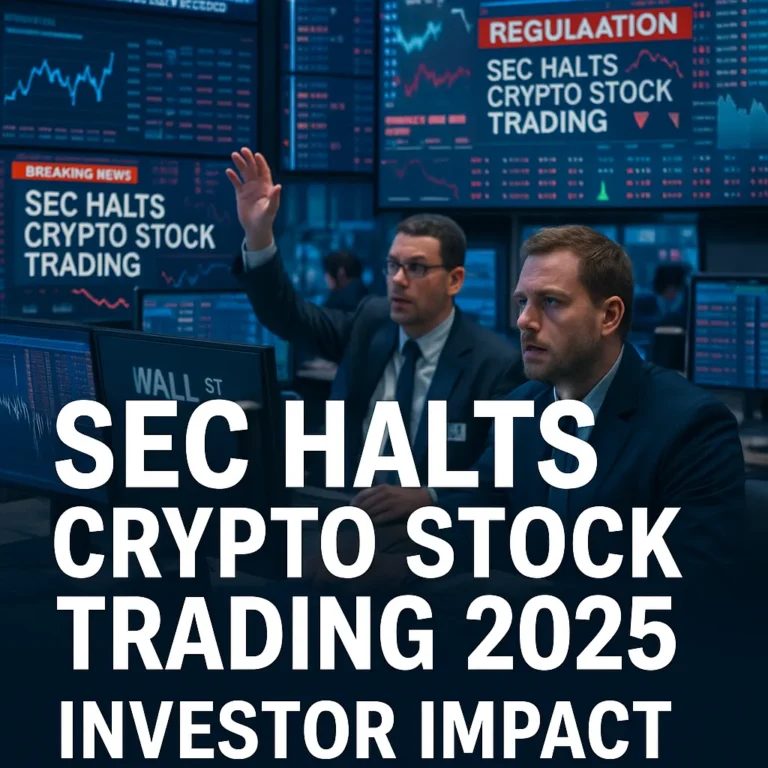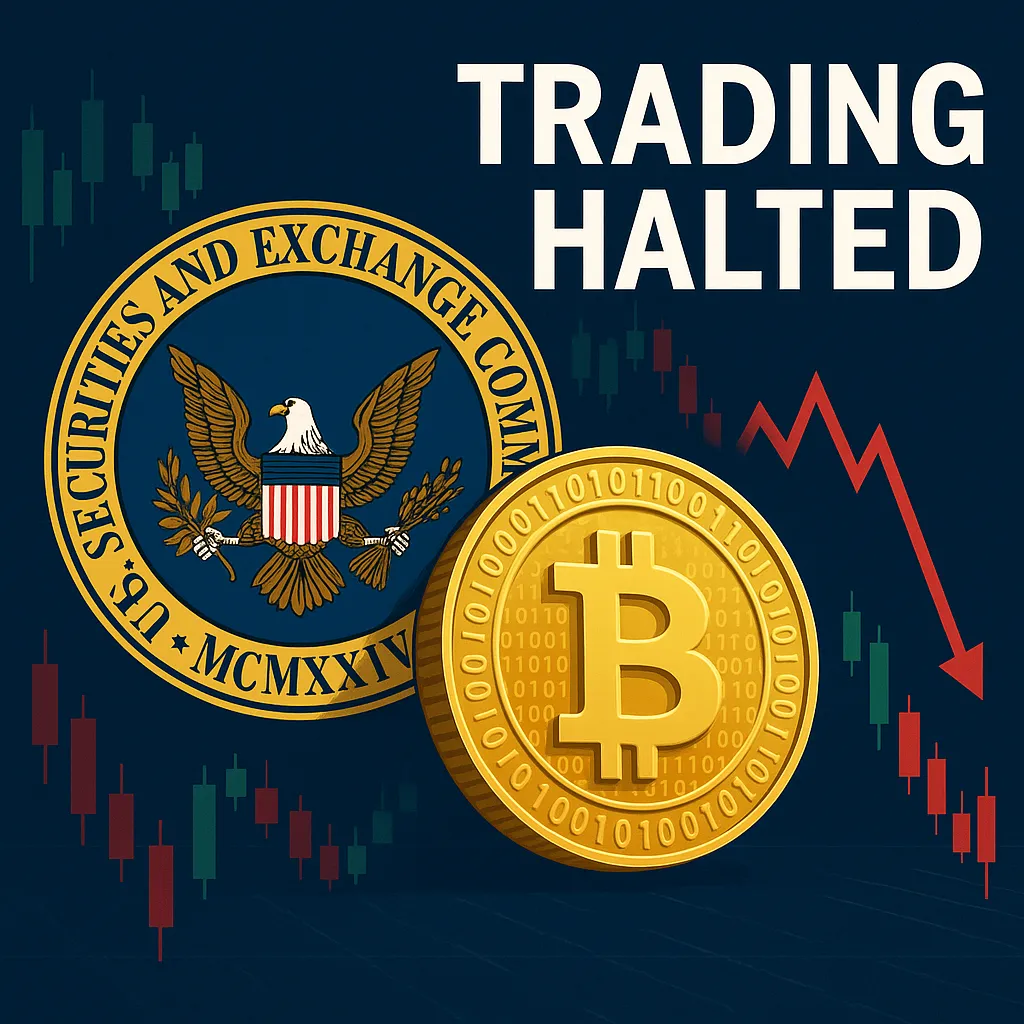
SEC Halts Crypto Stock Trading After 959% Surge — What It Means for Investors
When SEC halts crypto stock trading 2025 headlines hit, price action can disconnect from fundamentals in minutes. This brief explains why halts happen after outsized moves, what regulators look for, how volatility behaves around resumption, and the practical playbook retail traders can use to control risk.
Key Points
- 🛑 Why halts occur: Extreme price/volume, questionable disclosures, or market-manipulation signals.
- ⏱️ Timeframes: Trading can pause for minutes to days; reopening often brings gapped, whipsaw tape.
- 📈 Volatility profile: Spreads widen; liquidity fractures; first prints post-halt are not reliable anchors.
- 🔍 Due diligence: Read the SEC notice, issuer filings, and exchange bulletins before any re-entry.
- 🧯 Risk controls: Pre-define max loss, use limit orders only, and size positions as if ATR has doubled.
- 🧭 After resumption: Expect failed breakouts and mean-reversion traps—wait for structure, not headlines.
- 🔁 Portfolio posture: Consider diversifiers and non-correlated trades while the halt overhang persists.

How Media Outlets Covered the SEC Trading Halt
When SEC halts crypto stock trading 2025 headlines broke, mainstream outlets quickly framed the event around investor protection. Reuters and Bloomberg focused on the 959% surge that triggered the halt, while Coindesk highlighted the crypto community’s reaction to regulatory oversight.
Competitor coverage often emphasizes volatility and sensational price swings, but tends to stop short of offering traders concrete strategies. That’s why independent resources like Diversified Crypto Metals Portfolio Guide and actionable signal services give retail investors a more structured framework to operate with discipline instead of emotion.
Compared to broad-market news sites, our research highlights:
- ⚡ Entry/exit triggers for halted names once resumption occurs.
- 📊 Volatility-adjusted sizing to reduce risk of outsized losses.
- 🛡️ Cross-market hedging via metals or index futures to offset crypto risk.
Practical Playbook for Trading Around SEC Halts
When SEC halts crypto stock trading 2025 headlines hit, speed and discipline matter more than prediction. Treat the halt and the reopening as separate events with different risk profiles, and plan execution rules in advance.
Before Resumption
- Read the SEC/exchange notice and issuer filings; note the stated reason for the halt.
- Mark pre-halt high/low and key liquidity pockets (tape, book depth, imbalance data).
- Assume spreads will widen and first prints will be unreliable; plan limit orders only.
- Pre-define R (risk unit) and max daily loss; no discretionary overrides.
After Resumption
- Expect failed breakouts and sharp mean-reversion traps in the first 5–15 minutes.
- Scale in: 30% → 30% → 40% only after structure forms (higher low or lower high).
- Volatility-adjusted stops (e.g., ATR×1.5) paired with smaller size to keep R constant.
- No chasing gaps; use retests of levels for adds, not fresh market orders.
Position Sizing & Liquidity Rules
- Cap exposure in the halted name(s) to 10–15% of account until two stable 5-min closes print.
- Require 20-day median volume ≥ 1.5× your clip; if not, cut size in half or stand aside.
- Favor correlated hedges (index/metal exposure) to offset single-name gap risk.
Where This Fits in Your Playbook
If you specialize in fast tape and catalysts, halts are an edge case—treat them as event trades, not routine setups. If you prefer systematic signals, consider focusing on more liquid opportunities and alerts such as our Day Trade Alerts or watchlist updates fed from Penny Stock Alerts.
Want a refresher on mechanics and investor protections? Start at SEC.gov for official guidance, and use Investopedia for plain-English overviews of halt codes, volatility pauses, and reopening auctions.
Get Real-Time Alerts When Halts Hit
Entries, stops, and risk levels designed for high-volatility events. No hype—just rules.
Join TradeStockAlerts Cancel anytime. Educational content, not financial advice.
Sector & Regulatory Impacts of SEC Halts
The SEC halts crypto stock trading 2025 event highlights how fast-moving price spikes intersect with regulatory oversight. Such halts don’t just affect the halted ticker—they ripple across the broader crypto equity ecosystem, ETFs, and even sentiment in digital assets themselves.
Regulatory risk is not just about enforcement; it also shapes liquidity. Exchanges pause names to protect order flow integrity, but each pause carries reputational risk for issuers. As more crypto-linked equities list, investors must anticipate these shocks as a feature—not an anomaly—of the sector.
Ripple Effects on Markets
- 📊 Crypto miners: Stocks like RIOT and MARA often track sentiment and can spike in sympathy—then fade.
- 💹 ETFs & funds: Bitcoin spot ETFs may trade at discounts or premiums around high-profile halts.
- 📰 Media attention: Coverage in Reuters or Bloomberg can fuel FOMO in adjacent tickers.
For diversified positioning, investors may consider themes beyond single-name speculation—like those in our Diversified Crypto Metals Portfolio Guide.
Risk Matrix & Trade Setup Templates After an SEC Halt
When SEC halts crypto stock trading 2025 events occur, treat the tape like a special session: widening spreads, fractured liquidity, and headline whips can break typical patterns. Use a rules-first matrix to map volatility and liquidity to sizing, entries, and exits.
| Market State | Volatility (ATR/VWAP dev.) | Liquidity (spreads/depth) | Primary Risk | Sizing | Entry Style | Stop Logic |
|---|---|---|---|---|---|---|
| Pre-open imbalance | Unknown | Thin | Gap mispricing | Probe: 0.1R | Opening auction only | Hard stop beyond auction range |
| First 5–15 min | High / expanding | Wide | Slippage | 0.15–0.25R | Limit-on-retest of levels | ATR(14) × 1.5 + time stop |
| Structure forms | Moderate | Improving | Failed breakouts | Scale 0.3R → 0.3R → 0.4R | Higher-low / lower-high confirmation | Below/above last swing + trail after 1R |
| Late session | Normalizing | Better | Mean-reversion traps | 0.25–0.35R | Pullback to VWAP/MA confluence | ATR × 1.0; tighten into close |
Execution Rules You Can Print
- Read the official halt/resumption notice on the exchange or SEC.gov.
- Mark pre-halt high/low, VWAP, and opening auction range; set alerts.
- Use limits only until spreads compress; never chase first green/red bar.
- Cap single-name exposure at 10–15% of account until two stable 5-min closes.
- Journal each trade: slippage, spread at entry, reason for exit, and news context.
Playbooks by Cohort
Momentum Traders
Trade secondary pushes only after a higher low forms above VWAP.
- Trigger: Break/retest of prior micro-range
- Size: 0.25R max per add
- Invalidation: VWAP loss on rising volume
Mean-Reversion
Fade extensions only into confluence (prior high + band); avoid knife-catching.
- Trigger: Exhaustion wick + volume divergence
- Size: 0.2R initial
- Invalidation: Close beyond band + one bar
Swing/Position
Wait for daily close & issuer updates; use smaller risk and wider stops.
- Trigger: Daily inside break with follow-through
- Size: 50% of normal swing size
- Invalidation: Break of setup candle low/high
Diversifiers & Hedges
Use non-correlated exposure while the halt overhang persists: precious metals, broad equity indices, or cash. For ideas, see our Diversified Crypto Metals Portfolio Guide, and for intraday opportunities, tap Day Trade Alerts or scan Penny Stock Alerts.
Need a mechanics refresher? Check Investopedia for halt codes, and live tape context at CNBC / Bloomberg / Reuters.

Positioning for Medium- and Long-Term Investors
While traders focus on the immediate volatility of an SEC halts crypto stock trading 2025 event, long-term investors should view it as part of the broader regulatory maturation of crypto markets. These pauses often generate headlines, but they rarely alter the fundamental trajectory of blockchain adoption, digital asset integration, or equity-linked innovation.
Strategic Approaches for Investors
- 📈 Index & ETF exposure: Maintain diversified allocation in equity indexes and crypto-linked ETFs, trimming excessive concentration in small-cap names.
- 💰 Cash buffer: Hold 5–10% in cash to exploit opportunities created by volatility clusters.
- 🪙 Precious metals: Add stabilizers such as silver and gold, which often attract safe-haven flows (Diversified Crypto Metals Portfolio Guide).
- ⚡ Thematic growth: Maintain exposure to EV/critical materials sectors that remain resilient even under regulatory headwinds.
Historical Perspective
Regulatory halts have long existed across equities—from biotech FDA reviews to penny stock fraud cases. Crypto stocks are merely the newest cohort under the microscope. Historically, well-capitalized firms survive scrutiny, and sector ETFs normalize after initial volatility.
FAQs: SEC Halts Crypto Stock Trading 2025
Why did the SEC halt trading after a 959% surge?
Halts typically occur for investor protection when there are extreme price/volume spikes, questions about disclosures, potential manipulation, or pending material news. The pause lets regulators and exchanges review information before trading resumes.
How long do SEC or exchange halts usually last?
Ranges from minutes to days depending on the issue. Volatility pauses are brief; news pending or compliance-related halts can run longer. Always read the official notice before considering any trade.
What happens to price action when the stock reopens?
Spreads widen, liquidity fragments, and the first prints are often unreliable. Expect gapped moves, failed breakouts, and sharp mean-reversion attempts in the first 5–15 minutes.
How should retail investors manage risk around a halt?
Use limit orders only, pre-define max daily loss, size positions as if ATR has doubled, and avoid over-concentration in a single halted name. Consider diversifiers (metals, index exposure) while uncertainty clears.
Are halted crypto stocks inherently bad investments?
Not necessarily. A halt is a risk flag, not a permanent verdict. Evaluate fundamentals, capital structure, disclosures, and liquidity. Well-capitalized issuers can stabilize after scrutiny; others do not.
Where can I find official halt information?
Check SEC.gov and your exchange’s notices. For education and market context, see Investopedia and Reuters.
Conclusion
For SEC halts crypto stock trading 2025 scenarios, preparation beats prediction. Treat the halt and the reopening as distinct events, set volatility-aware position sizes, and wait for structure before committing capital. Diversify beyond the headline ticker and revisit your thesis once filings and data catch up to price.
Trade With Rules—Not Headlines
Get disciplined entries, exits, and risk levels tailored to high-volatility events.
Get Day Trade Alerts Educational content. Not financial advice. Cancel anytime.
Pauline Lei
Pauline Lei is a financial markets writer at TradeStockAlerts.com. She covers crypto-equity intersections, event-driven trading, and metals diversification strategies, focusing on risk-first frameworks for retail investors.